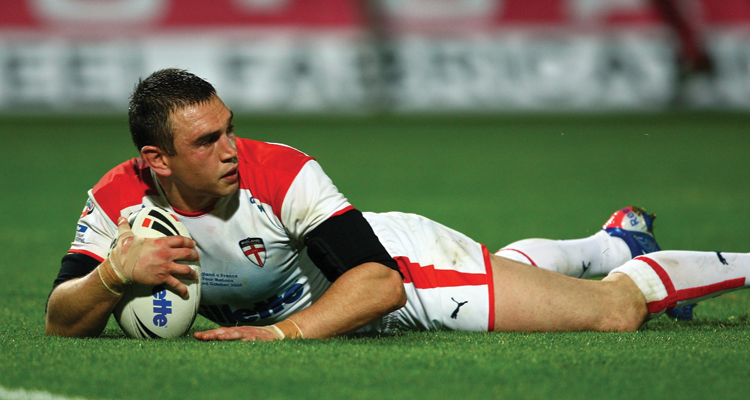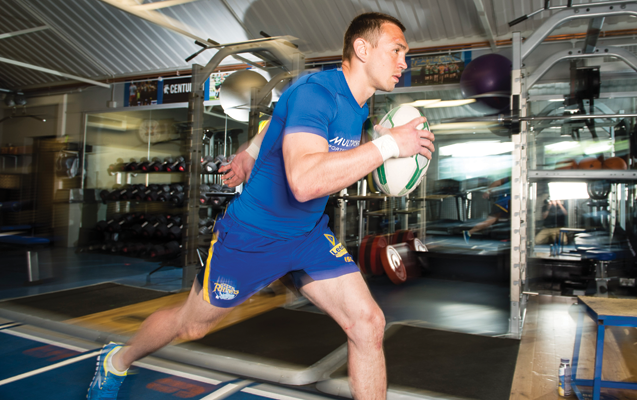
Rugby league is tough. The pace of the game is full throttle, the collisions brutal and the intensity ferocious. It helps to be big and strong, but to stand out you need the complete package. In other words, "It’s all right being able to lift a cow, but if you can’t catch one what’s the point?"
Those are the words of Kevin Sinfield, the England and Leeds Rhinos captain and kicker who has led his club to unprecedented success in Super League. At the start of 2013 he received the prestigious Golden Boot, awarded to the best player in the world – an honour traditionally dominated by stars playing in the southern hemisphere. And last October he led England to within just two points of a home World Cup final, being narrowly beaten 18-20 by New Zealand.
But none of this would have been possible if he didn’t know the best way to make the most of his physical ability.
Interview With Kevin Sinfield
Physically, what was the biggest turning point in your development?
When I first joined Leeds 15 years ago we’d hammer the weights sessions – at one point I didn’t do any running for three months. I was actually bigger when I was younger. By 22, I started to feel like I wasn’t fit enough and that I was too heavy for my structure. Our conditioning set-up changed and we agreed to focus on more running. It was more important for me to be fit than strong. Regularly resetting your goals like this is important to make sure you train intelligently.
If not size, what is the key physical ability needed for rugby league?
We need to be able to run. I don’t mean long distances but at different speeds for lengthy periods of time. So we do varied-pace interval running. You need to be strong and powerful, but rugby league tests every facet of your fitness. You could have very good endurance but when you get hit and you’ve got to get up off the ground with three men on top of you it tests everything.
How tough is pre-season training?
That’s when the hard work gets done. We’ll do four heavy weights sessions a week, with two upper and two lower-body moves, plus some swimming for mobility. And we have bruising contact sessions where you’re just bashing into each other to get your body prepared for matches. We’ll spend most of it with serious DOMS [delayed onset muscle soreness] struggling even to sit on the toilet. Non-internationals who start pre-season earlier will build up gradually with more cardio work. They’ll start with longer-distance runs and taper down to short, sharp, intense intervals.
How does that prepare you for your first match of the season?
Before the first game you feel good and strong, but no matter how much training you’ve done it never seems to prepare you for the game itself. You can be in the best condition you’ve ever been in but you’ll get into a game and you can’t understand why you’re so tired. It takes three or four games to get there but everyone’s in the same boat – no matter if you’ve had three months or three weeks to prepare.
Get the Coach Newsletter
Sign up for workout ideas, training advice, reviews of the latest gear and more.
How do you train between matches?
We achieve most of our fitness from matches, so during the season most of the work we do in training is maintenance. There’s no point blasting your legs in the gym. Physically you’ll struggle and mentally you’ll go into a match feeling rubbish. There’s no better feeling than waking up on game day and feeling fresh, with a spring in your legs and loads of energy.
How do weights sessions change?
In season we cut back our weekly weights sessions to only one or two and drop the weight considerably. Out of season I do 100kg deep squats for ten-rep sets, but during the season I drop that to 60kg for six supersets with 40kg powerful jump squats. I make sure I get really deep to improve my mobility.
Do you find any aspect of your training difficult?
I’ve never really struggled with any aspect of fitness. I’ve always slept well, and have never struggled with weight or recovery. But I do treat myself with dark chocolate, which can actually be quite good for you. If you’re going to eat chocolate it might as well be the best.
What supplements work for you?
Apart from protein shakes after training and matches, I don’t take any supplements. I get everything I need from my diet. I used to take caffeine before matches but now I prefer anything that will keep me relaxed. I don’t eat too much before a game either. I like to feel empty on game day.
How do you recharge your batteries away from rugby league?
The season is so intense and there’s practically no break between one and the next, but I let off steam by spending time with my family. If I’m not training I’ll have contractual obligations to fill, but I find it helps if I switch my phone off to get away from it all.
Kevin Sinfield uses Multipower Sportsfood. For sports nutrition tailored to your individual needs, visit multipower.com
Kevin Sinfield's Power Workout
Build power with these moves devised by Richard Hunwicks, Sinfield’s strength and conditioning coach at Leeds Rhinos and England.
1A Half squat
Sets 3 Reps 5
Begin in a back squat position with the bar on your upper back.
Lower into a squat but only go halfway before accelerating back up.
Hunwicks says: "By going only halfway you use the highest possible load to stimulate the maximum amount of muscle fibres."
1B 10m sprint

Sets 3 Reps 5
From a standing start accelerate forwards, reaching top speed as soon as possible. Keep your core tight to transfer power from your lower to upper body.
Slowly walk back to the start before repeating. Do the move holding a rugby ball to simulate a match situation.
Hunwicks says: "These short-distance sprints develop rapid acceleration to evade your opponent and break tackles."
2B Hurdle jump to 10m sprint
Sets 3 Reps 3
Stand in front of a thigh-high hurdle. Lower into a quarter squat before exploding over the hurdle. As soon as your feet touch the floor, accelerate into a sprint. Stop after 10m and slowly walk back to the start.
Hunwicks says: "Try to limit the amount of time your feet are on the floor before accelerating to teach quick reactions."
3A Hang snatch
Sets 3 Reps 3
Hold a bar with a wide grip above your knees. Drive your hips forwards to straighten up, lifting the bar without bending your arms. As the bar rises, drop under it and extend your arms above your head. Stand to finish.
Hunwicks says: "The snatch teaches good body alignment and strengthens the shoulder girdle and rotator cuff muscles."
3B 20m sled drag
Sets 3 Reps 3
Attach a weighted sled behind you and sprint with good form, keeping low.
If you don’t have a sled, place weight plates on a towel in front of you and push them.
Hunwicks says: "This is a great way to build explosive power because it mimics your normal sprinting. Just don’t go too heavy or it will alter your running mechanics."
4 Single-leg clean to box
Sets 5 Reps 5
Stand facing a knee-high platform holding the bar just above knee height. Lift one leg off the floor behind you so you’re balancing on one leg.
Using the same movement as the power clean, lift the bar to your chest. At the same time, lunge your raised leg forwards to land on the box.
Hunwicks says: "This encourages open extension of the hip, ankle and knee for improved mobility."

Sam Rider is an experienced freelance journalist, specialising in health, fitness and wellness. For over a decade he's reported on Olympic Games, CrossFit Games and World Cups, and quizzed luminaries of elite sport, nutrition and strength and conditioning. Sam is also a REPS level 3 qualified personal trainer, online coach and founder of Your Daily Fix. Sam is also Coach’s designated reviewer of massage guns and fitness mirrors.
